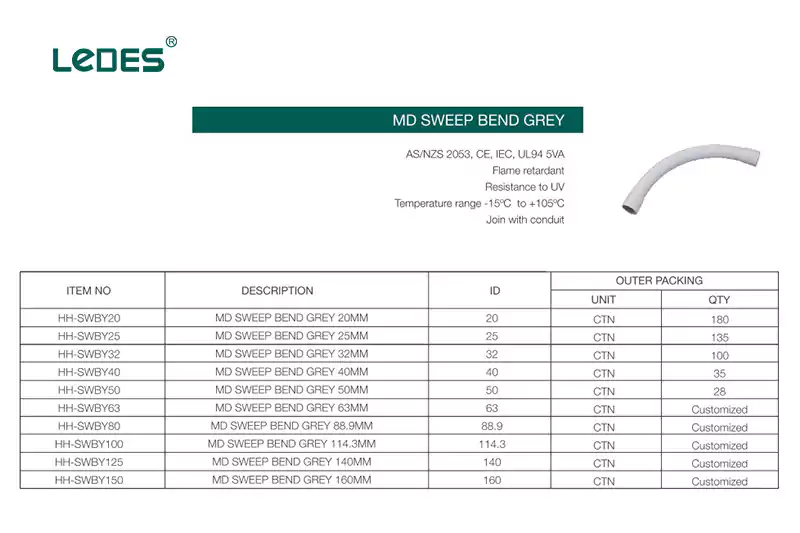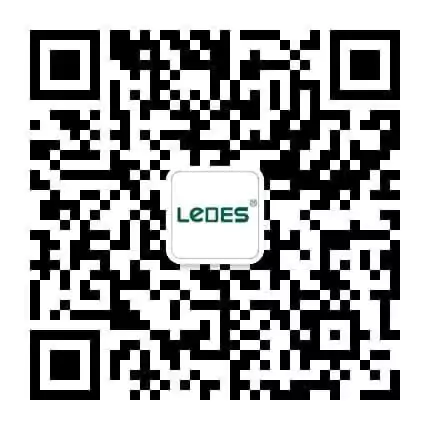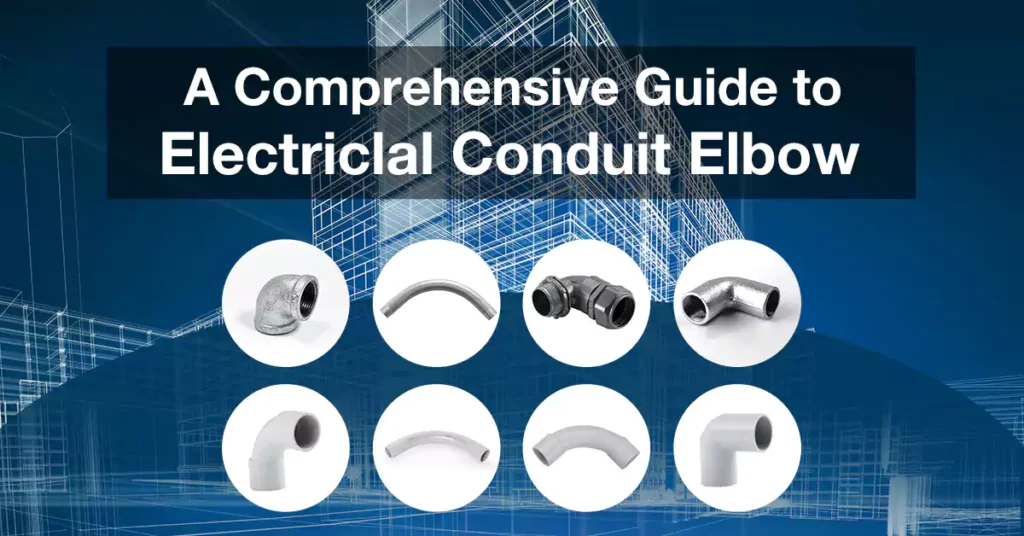
目录
在电气安装过程中,导管系统作为关键组件发挥着至关重要的作用。该系统由导管和配件组成,用于保护和组织电线。这样,它可以预防潜在危险,并确保电力的无缝传输。在众多配件中,有一种称为导管弯头的特殊类型在任何电气安装项目中都至关重要。在本指南中,我们将探讨导管弯头的所有重要方面,以帮助您更好地了解这种导管配件。
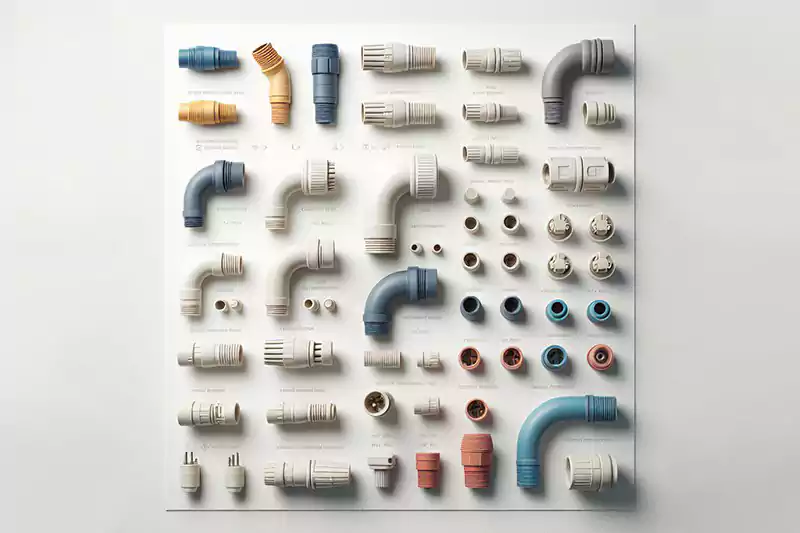
电气导管弯头是一种用于电气安装的配件,用于改变导管系统的方向。它用于以一定角度连接两段导管,使线路能够通过拐角、弯道或方向变化。导管弯头通常由金属或非金属材料制成,并提供各种尺寸以适应不同的导管直径。
这些弯头对于安全有序地布线至关重要。它们可以保护电线免受损坏,并使安装看起来整洁专业。弯头使导管系统能够顺利穿过障碍物并改变方向,从而有助于保持电线的完整性,并防止电线拉伤、急弯或意外损坏等潜在危险。
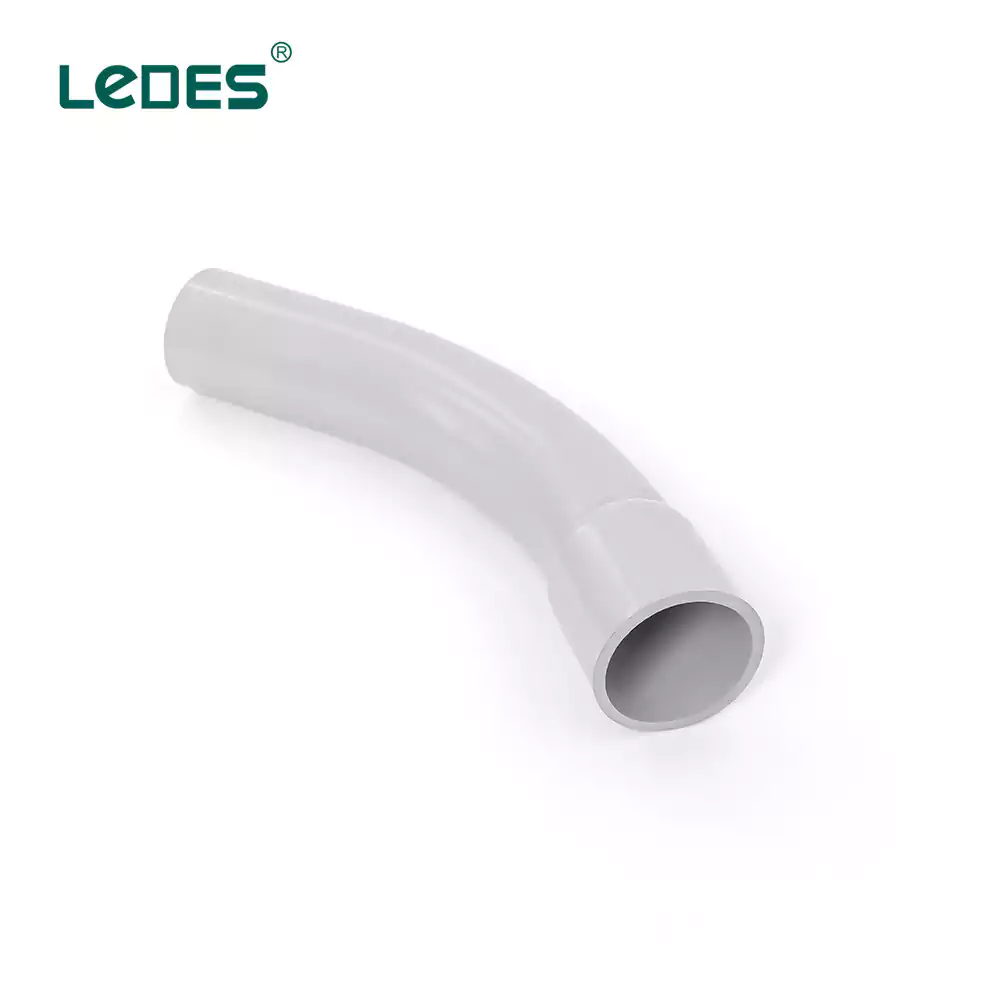
30度弯头: 这种肘部可以形成 30 度的适度转弯,与 45 度或 90 度等较大角度相比,方向变化更为平缓。
22.5度弯头: 22.5 度弯头主要用于当管道系统需要轻微弯曲或需要以不如 45 度或 30 度转弯那么急的角度转弯时。
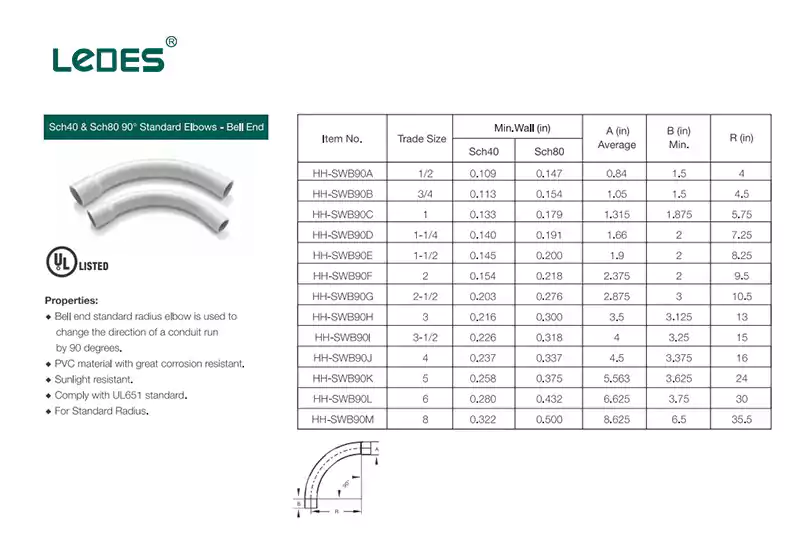
在美国和加拿大,他们确实广泛使用这些类型的弯头来帮助在管道系统中实现不同的角度转动,但与美国 UL 和加拿大 CSA 标准弯头相比,尺寸和一些性能要求略有不同。
以下是 UL 和 CSA 标准的尺寸。
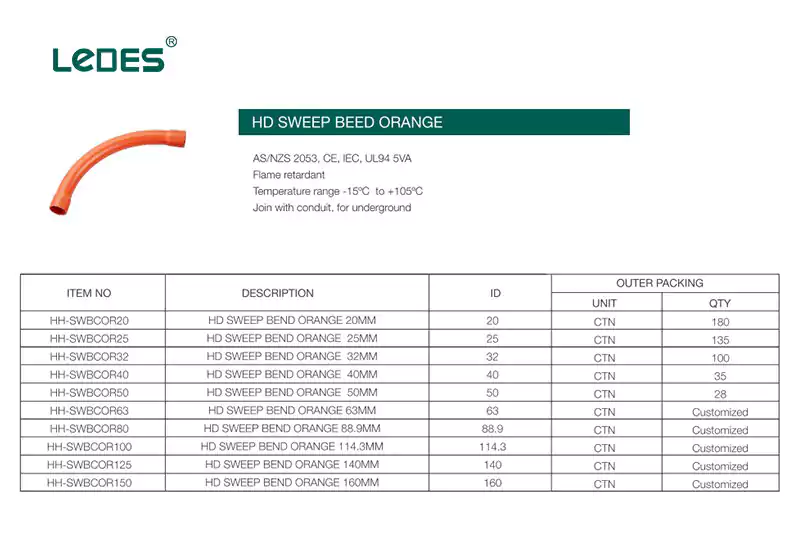
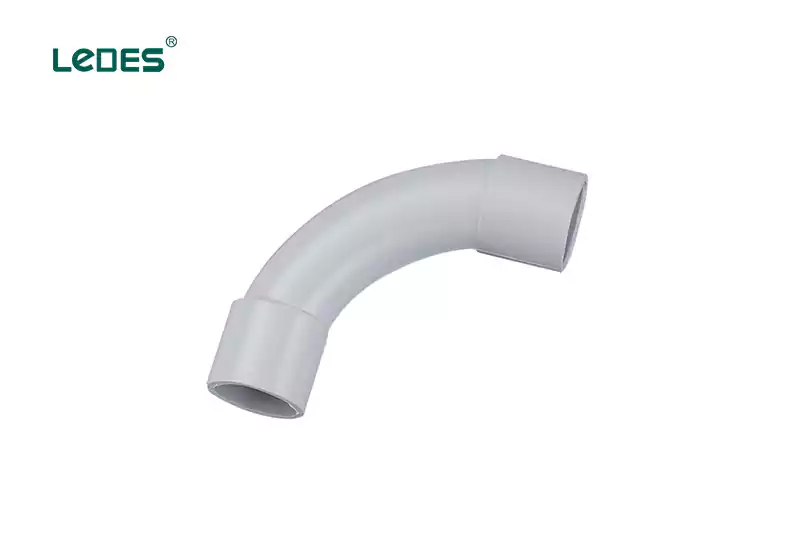
标准弯头: 标准弯头(也称为标准弯头)是一种通用的导管配件,用于改变导管系统的方向。这些弯头通常具有固定角度,通常为 90 度,并且广泛适用于各种尺寸的导管。
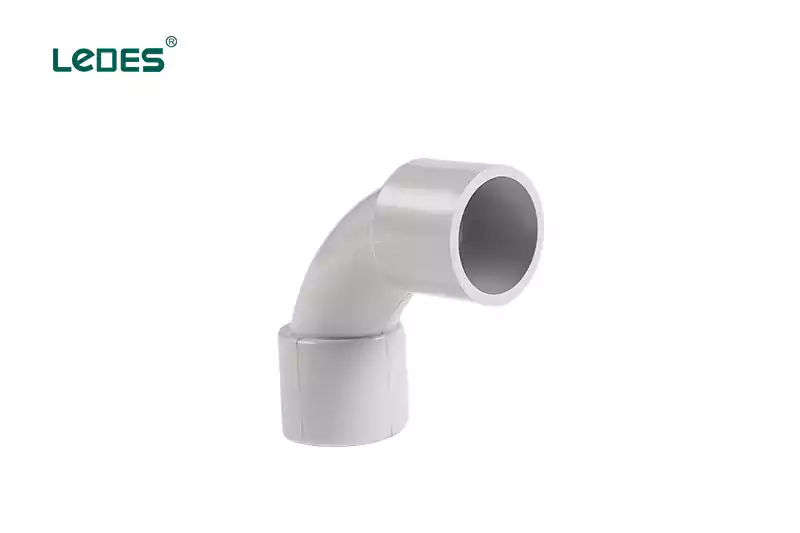
实心弯头: 实心弯头是一种导管配件,可为导管系统提供刚性且不可移动的方向改变。它通常由与导管本身相同的材料制成,用于需要永久牢固的角度的情况。
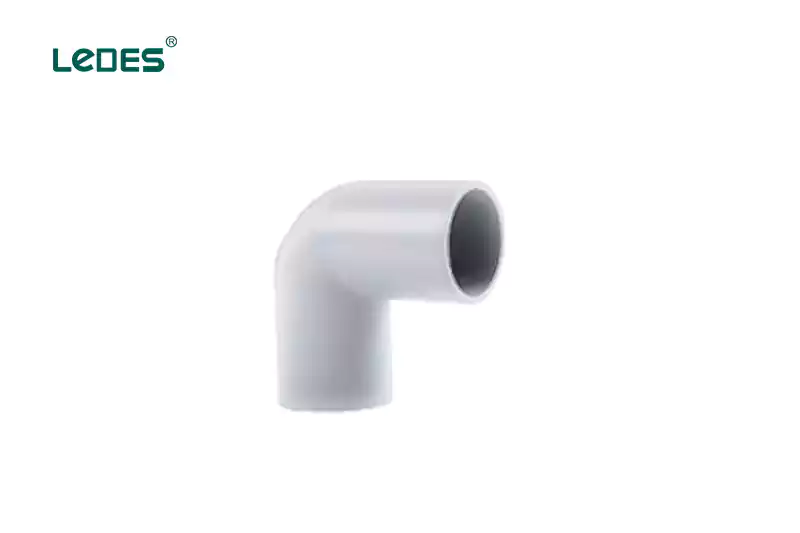
90度弯头: 90 度方向改变的弯头,无插座端。
标准弯头(也称为标准肘管)是一种常用的导管配件,可为导管系统提供固定角度的方向变化。这些弯头通常具有预定角度,最常见的是 90 度,并且有各种尺寸可供选择,以适应不同的导管直径。
标准弯头的主要特征包括:
- 固定角度:标准弯头具有固定角度,例如 90 度、45 度或其他常见角度。它们在管道系统中提供急转弯,允许以特定角度改变方向。
- 预定义规格:标准弯头按预定义规格制造,包括弯头角度以及设计适用导管的直径或尺寸。这些规格已标准化,在市场上广泛供应。
特殊弯头,也称为定制弯头或定制弯管,是指专门设计和制造以满足曲率和规格方面的独特要求的导管配件。与标准弯头不同,特殊弯头可以根据具体项目需求灵活地定制弯头的角度和尺寸。
特殊弯头的主要特点包括:
- 可定制曲率:特殊弯头可定制曲率,从而实现导管系统的精确角度和转弯。这种定制功能使配件能够满足具体的安装要求,适应独特的障碍物、建筑特征或空间限制。
- 定制规格:特殊弯头是定制配件,可根据具体项目规格定制。这些规格包括弯曲角度、曲率半径、导管直径或尺寸以及其他所需尺寸。
- 制造工艺:特殊弯头通常通过专门的制造工艺制造,包括将导管弯曲到所需的角度和曲率,以确保精确适合特定的应用。
总而言之,标准弯头和特殊弯头的主要区别在于能否定制曲率和规格。标准弯头提供固定角度和预定义规格,而特殊弯头则能够灵活地定制弯头的角度、半径和尺寸,以满足独特的项目需求。
不同国家/地区的电线管弯头尺寸可能有所不同,使用的计量单位也可能不同。以下将重点介绍美国和澳大利亚之间的差异,并概述常用尺寸。
在美国,电线管弯头通常以行业尺寸来表示,这些尺寸代表了电线管的大致内径 (ID)。常见的行业尺寸包括 1/2 英寸、3/4 英寸、1 英寸、1-1/4 英寸、1-1/2 英寸、2 英寸、2-1/2 英寸、3 英寸、3-1/2 英寸、4 英寸及更大尺寸。
在澳大利亚,电线管尺寸通常采用公制,具体单位为毫米 (mm)。弯头最常用的公制尺寸包括 16 毫米、20 毫米、25 毫米、32 毫米、40 毫米、50 毫米、63 毫米、80 毫米、100 毫米及更大。
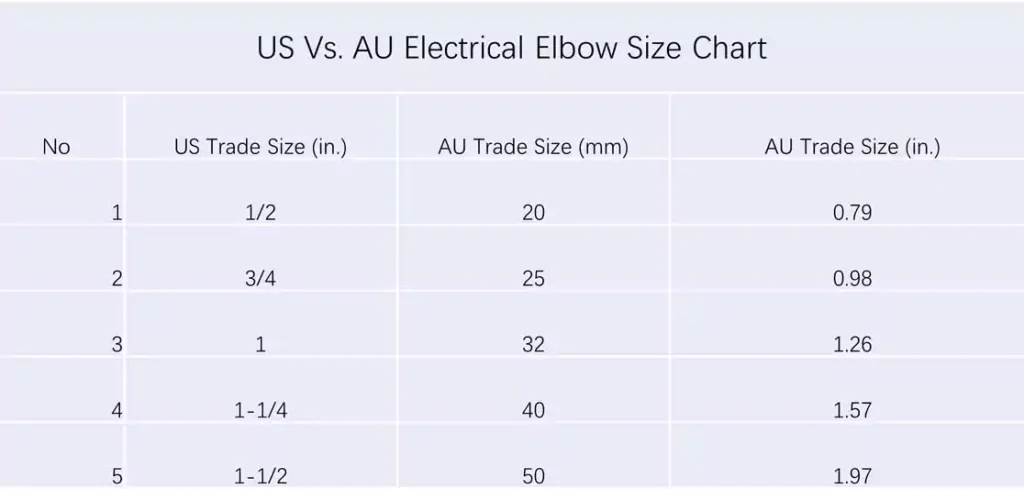
电气导管弯头主要分为两大类:塑料和金属。每类中,都有一些常用于制造电气导管弯头的特定材料。
- PVC(聚氯乙烯):PVC 因其价格实惠、重量轻且易于安装,是塑料弯管的热门选择。PVC 耐腐蚀,并提供良好的电绝缘性。PVC 弯管常用于住宅和商业用途。
- 玻璃纤维: 玻璃纤维导管弯头由嵌入树脂基体的玻璃纤维增强塑料制成。它们具有出色的耐腐蚀、耐化学性和耐极端温度性能。玻璃纤维导管弯头通常用于对耐用性要求严格的工业和恶劣环境中。
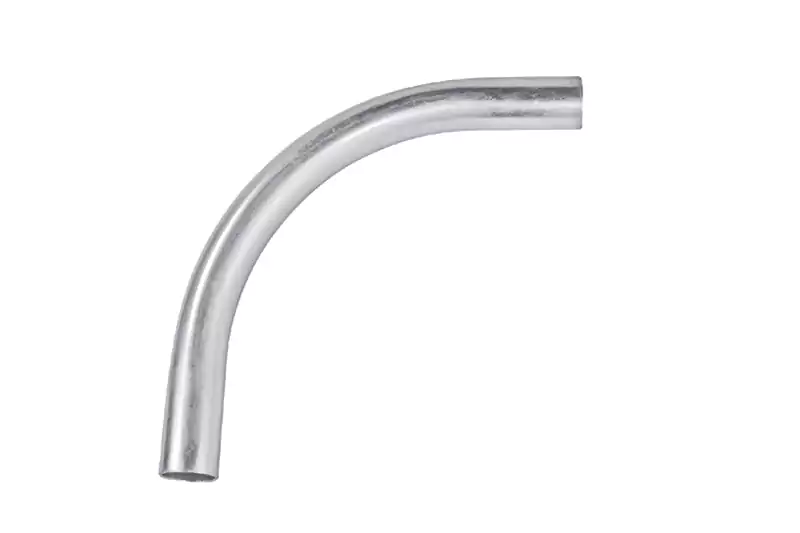
- 镀锌钢: 镀锌钢制弯管由钢材制成,表面镀锌,具有耐腐蚀性能。它们坚固耐用,广泛应用于商业和工业领域。镀锌钢制弯管以其高机械强度而闻名,适合户外安装。
- 钢: 钢制弯管由普通钢材制成,未添加任何保护涂层。它们坚固耐用,但容易生锈。钢制弯管通常用于工业环境,这类环境对耐用性要求较高,但耐腐蚀性可能并非首要考虑因素。
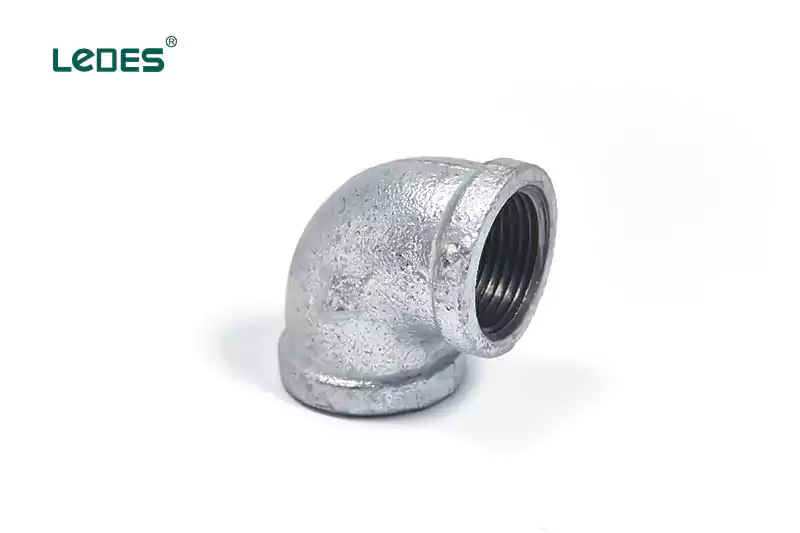
- 铝: 铝制弯管重量轻、耐腐蚀且易于安装。它们通常用于住宅和轻型商业用途。铝制弯管因其重量轻、耐锈蚀和腐蚀等特性而备受青睐。
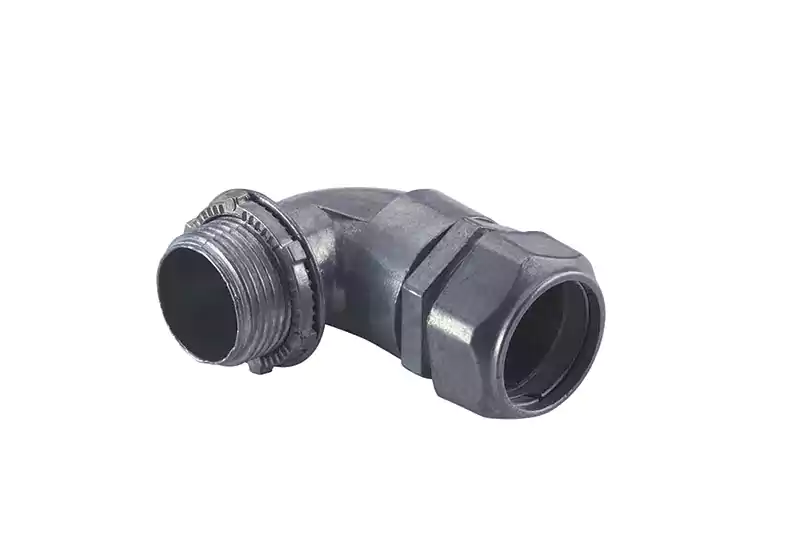
- 锌: 锌制弯管由钢材制成,表面镀锌以防腐蚀。它们具有中等强度和耐腐蚀性。锌制弯管常用于注重耐用性和成本效益的室内电气安装。
选择导管弯头的材料时,务必考虑项目需求。金属材料强度更高,理论使用寿命更长,但重量更重,也更容易生锈。另一方面,塑料材料不会生锈,重量更轻,而且性价比更高。然而,它们的强度可能低于金属弯头,理论使用寿命也相对较短。
最终,导管弯头材料的选择取决于项目需求、预算、环境条件以及耐用性、耐腐蚀性、重量和成本之间的理想平衡等因素。
弯头主要用于改变电线管的走向。以下是其用途的概述:
- 方向改变: 导管弯头主要用于改变电气导管的走向。它们使导管能够平稳、渐进地转向,从而绕过障碍物、拐角或其他结构元件。弯头有各种角度,例如 90 度、45 度、30 度和 22.5 度,为导管系统的布线提供了灵活性。
- 电缆保护: 弯头有助于最大程度地减少过度弯曲,从而保护导管内的电缆。电线急剧弯曲时,绝缘层可能会变形,导致损坏或过早磨损。导管弯头能够以可控的方式逐渐改变方向,从而降低绝缘层磨损、电线断裂或电气故障的风险。
- 空间优化: 在狭小空间或导线管布线空间有限的区域,弯头对于优化空间利用率至关重要。弯头允许导线管进行急转弯或通过拐角,从而实现高效的布线,并有助于确保导线管系统能够适应可用空间。这在空间受限或建筑特征对安装造成挑战的应用中尤为重要。
- 访问和拉取: 某些类型的弯头用于与接入和拉线相关的特定用途。内角弯头设计用于需要接入线槽的拐角处。它们具有可拆卸的盖子或接入点,方便维护或拉线。拉线弯头(也称为扫线弯头)具有较大的弯曲半径,方便将电线拉过导管。它们可以最大限度地降低安装或添加或更换电缆时电线损坏的风险。
通过在电气安装中使用导管弯头,专业人员可以实现高效的布线,保护电缆,适应具有挑战性的空间,并确保维护或未来改造的便捷性。这些多功能配件在构建设计精良、功能齐全的导管系统方面发挥着至关重要的作用。
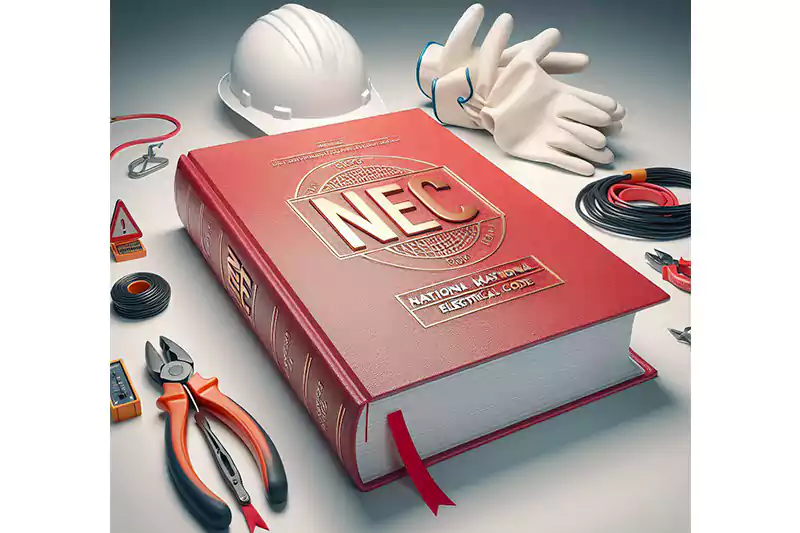
PVC 导管弯头对当地规范的遵守情况因地区而异,例如美国(UL651)和澳大利亚(AS/NZS 2053)。以下是基于 UL651 和 AS/NZS 2053 的一些差异示例:
- 类型要求
澳大利亚标准 AS/NZS 2053 明确规定了从轻型到超重型不同类型导管弯头的测试要求。该标准还包含具体的抗冲击数值要求。此外,AS/NZS 2053 还要求在导管弯头上进行标记,并在导管表面印上相应的工作类型,例如轻型 (LD) 或重型 (HD)。这样可以轻松识别导管的强度等级。相比之下,UL651 对导管弯头的标记没有具体要求。
- 火焰测试定义
UL651 和 AS2053/NZS 2053 的阻燃性定义和测试程序也不同:
UL651 规定,配件(包括导管弯头)在第三次施加测试火焰后,燃烧时间不得超过 5 秒。此外,还规定在施加测试火焰期间或之后,配件上不得掉落任何燃烧颗粒或水滴。
AS/NZS 2053 详细描述了火焰测试程序。该标准要求燃烧器与垂直方向保持 45±2° 的夹角。将火焰施加到管道样品上,使燃烧器管顶部到顶部的距离(沿火焰轴线测量)应为 100±10 毫米,火焰轴线应与样品表面相交于距离下夹具上端 100±5 毫米的点,并且火焰轴线应与样品轴线相交。
火焰施加时间为60±1秒,测试期间样品不得移动。AS2053还规定,火焰测试应在三个样品上进行。
请注意,所提供的信息来源于澳大利亚标准协会和 UL(美国保险商实验室公司),这些组织对所提及的标准拥有最终解释权。
综上所述,不同地区检测标准的差异,会导致导管弯头的性能指标存在差异。但只要产品符合当地规范要求,其质量和适用性是可以保证的。
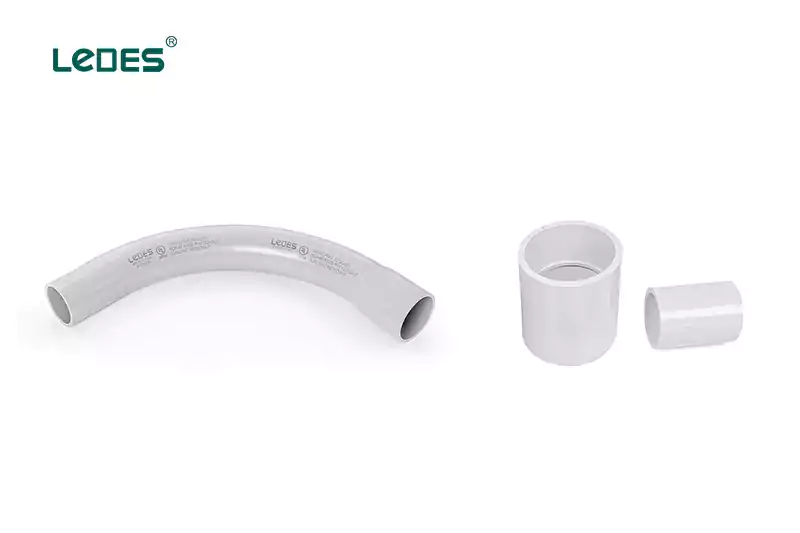
外貌:
首先,两者的外观很容易区分。弯头通常呈弯曲状,类似于管道的弯曲部分。而耦合器则采用直线设计,类似于管道的直线部分。
目的:
导管弯头和连接器之间的主要区别在于它们的设计和用途。导管弯头主要用于改变导管的走向。它们有45度和90度的预制弯头,适用于金属和非金属导管。内角弯头和拉力弯头在狭小空间或需要进入线槽时尤其有用。
另一方面,连接器通常用于将导管管路连接到明装插座或开关底盒。它们可以连接导管的不同部分,方便导管管路的连续性,或将其连接到插座或接线盒。
由于其独特的设计和预期用途,在采购和施工过程中避免混淆导管弯头和耦合器非常重要。
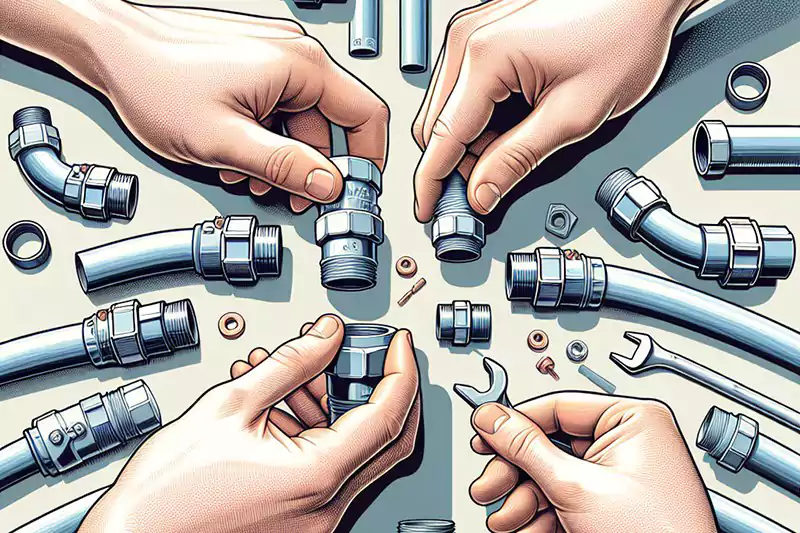
- 收集必要的材料和工具:
金属导管弯头
金属导管
导管连接器或联轴器
钢锯或管道切割机
去毛刺工具或美工刀
螺丝刀或扳手(如果连接器需要)
- 测量并切割金属导管:
确定通向弯头的导管所需长度。
使用钢锯或切管机将金属导管切割至合适的长度。确保切口平直、整齐。
- 准备金属导管弯头:
松开弯头上的所有固定螺钉或锁紧螺母以打开它们。
- 将金属导管连接到弯头:
将金属导管的一端插入弯头的开口端。
如果金属弯头有固定螺钉或锁紧螺母,请将其拧紧以将导管固定到位。
如果使用联轴器或连接器,请按照制造商的说明将导管连接到弯头。
- 连接剩余的金属导管:
重复步骤 4 中概述的过程,将额外的金属导管连接到弯头的另一端。
使用接头或连接器将金属导管牢固地连接在一起。用螺丝刀或扳手将其适当拧紧。
- 固定金属导管组件:
确保金属导管组件正确对齐并得到支撑。
使用带子或导管夹将导管固定到墙壁或其他合适的表面上。

- 收集必要的材料和工具:
塑料导管弯头
塑料导管
导管连接器或联轴器
钢锯或管道切割机
去毛刺工具或美工刀
导管水泥
- 测量并切割塑料导管:
确定通向弯头的导管所需长度。
使用钢锯或切管机将塑料导管切割至合适的长度。确保切口平直、整齐。
- 准备塑料导管弯头:
使用去毛刺工具或美工刀清洁导管的末端和弯头的内部,以去除任何毛刺或粗糙的边缘。
- 将塑料导管连接到弯头:
将导管胶粘在弯头内侧和塑料导管外侧。
将导管插入弯头并用力握住几秒钟以使水泥凝固。
- 连接剩余的塑料导管:
重复步骤 4 中概述的过程,将额外的塑料导管连接到弯头的另一端。
Use couplings or connectors to securely join the plastic conduit pipes together. Follow the manufacturer’s instructions for installation.
- Secure the plastic conduit assembly:
Ensure that the plastic conduit assembly is properly aligned and supported.
使用带子或导管夹将导管固定到墙壁或其他合适的表面上。
Remember to follow any specific instructions provided by the manufacturer of the conduit elbows and connectors you are using. Additionally, adhere to local electrical codes and regulations when installing conduit for electrical wiring purposes. If you are uncertain about any aspect of the installation, it is advisable to consult a qualified electrician or professional.

Here is a general outline of the manufacturing process for plastic PVC elbows:
- PVC resin preparation: The first step is to prepare the PVC resin by blending it with additives and stabilizers to achieve the desired properties such as strength, flexibility, and resistance to UV rays and chemicals.
- Extrusion of PVC pipes: The PVC resin is fed into an extruder machine, where it is heated and melted to form a molten PVC compound. The molten PVC is then pushed through a die, which gives it the shape of a continuous pipe. The extruded pipe is cooled and solidified as it passes through a water bath or cooling chamber.
- Mold preparation: Mold cavities are prepared for the elbow shape. These molds are typically made of metal and consist of two halves that fit together. The mold cavities are precisely machined to create the desired elbow shape and dimensions.
- Injection molding: In this step, the cooled and solidified PVC pipes from the extrusion process are cut into specific lengths and fed into an injection molding machine. The injection molding machine consists of a heated barrel and a screw mechanism. The PVC pipe pieces are introduced into the barrel, where they are melted and transported by the screw to the mold cavity.
- Molding the elbow shape: The molten PVC is injected into the mold cavity at high pressure. The mold is designed to create the elbow shape, including the desired angle and radius. The PVC material fills the mold cavities and takes the shape of the elbow.
- Cooling and solidification: After the PVC material is injected into the mold, it is allowed to cool and solidify. Cooling can be accelerated through the use of cooling channels or water sprays. This step ensures that the PVC material retains its shape and stability.
- Mold opening and ejection: Once the PVC material has solidified, the mold is opened, and the newly formed PVC elbow is ejected from the mold cavity. The ejection can be facilitated through the use of ejector pins or air blasts.
- Trimming and finishing: The ejected PVC elbows may have excess material or flash that needs to be removed. Trimming is carried out to remove any unwanted portions and achieve a smooth, finished surface. This can be done manually or using automated trimming equipment.
- Quality control and inspection: The PVC elbows undergo quality control checks to ensure they meet the required specifications and standards. This may include dimensional checks, visual inspections, and tests for strength and durability.
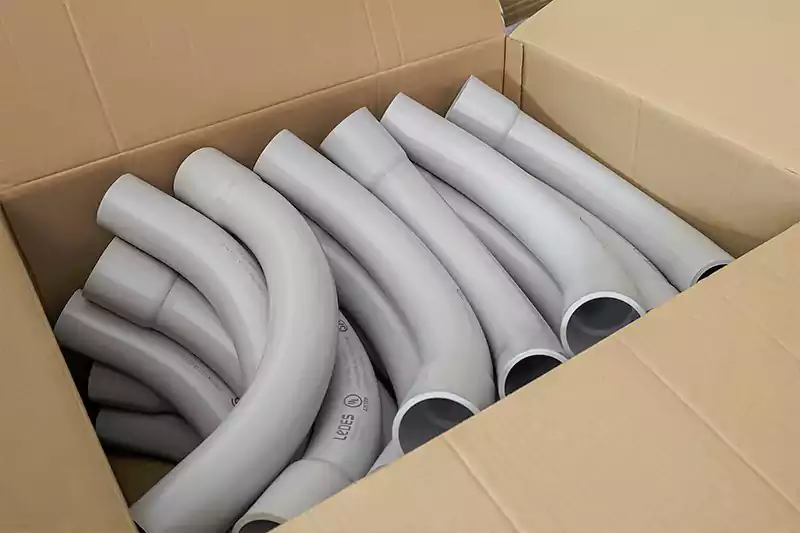
- Packaging and distribution: After passing the quality control checks, the PVC elbows are packaged and prepared for distribution. They may be bundled, boxed, or placed on pallets, depending on the manufacturer’s packaging standards. The packaged PVC elbows are then shipped to distributors or customers.
Assess the basic needs of the product based on your project or usage environment. For example, determine whether you need the elbows for embedding in standard residential buildings, long-term outdoor use, or if they will be exposed to humid conditions. By considering the advantages and disadvantages of various elbow products, we can help you make the right choice. If you are a project contractor or distributor, please contact us for further purchasing advice.

Select products that fit your project within your budget. This ensures that you meet project requirements while minimizing procurement costs and obtaining good-quality products. In addition to the cost of purchasing the products, consider transportation and installation costs. For instance, as mentioned earlier, metal elbows are heavier, resulting in increased transportation and installation expenses. Therefore, it’s important to factor in these costs when allocating your total budget.
Based on installation and construction requirements, determine the quantity and quality standards needed. This allows you to purchase the desired quantity of elbows within your budget while meeting quality requirements.
Different types of elbows are available from various brands. Purchasing products from reputable brands may come at a slightly higher price, but the quality is significantly better. Well-known brands have undergone local certifications. Buying unknown brands may result in potential quality issues, and the resulting losses could far exceed the product’s value. If local brand prices are too high or you require bulk purchases, you can consider purchasing directly from manufacturers, such as Ledes. As a manufacturer, Ledes operates as a factory without intermediaries, offering relatively lower prices. Moreover, with over 14 years of export experience and serving thousands of customers, Ledes ensures timely delivery of goods once you place your order.
If you would like to inquire about our products, 请点击此处向我们发送电子邮件。
In conclusion, conduit elbows play a crucial role in electrical installations, providing flexibility and efficient routing of wires and cables. This article has provided a comprehensive overview of conduit elbows, covering their types, materials, sizes, and installation considerations.
Remember, selecting the right conduit elbows is essential for a safe and efficient electrical installation. By choosing our high-quality products, you can ensure reliable performance and peace of mind for your projects.
If you are interested in conduit elbows, as a manufacturer, we offer PVC elbow wholesaler prices. You can submit a contact form 或者 email us to request a product catalog and quotation free of charge. We are dedicated to providing high-quality conduit elbows and excellent customer service. Don’t hesitate to reach out to us for more information or to place an order. We look forward to serving you!


